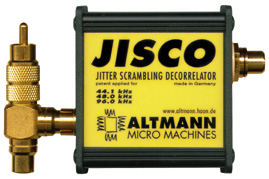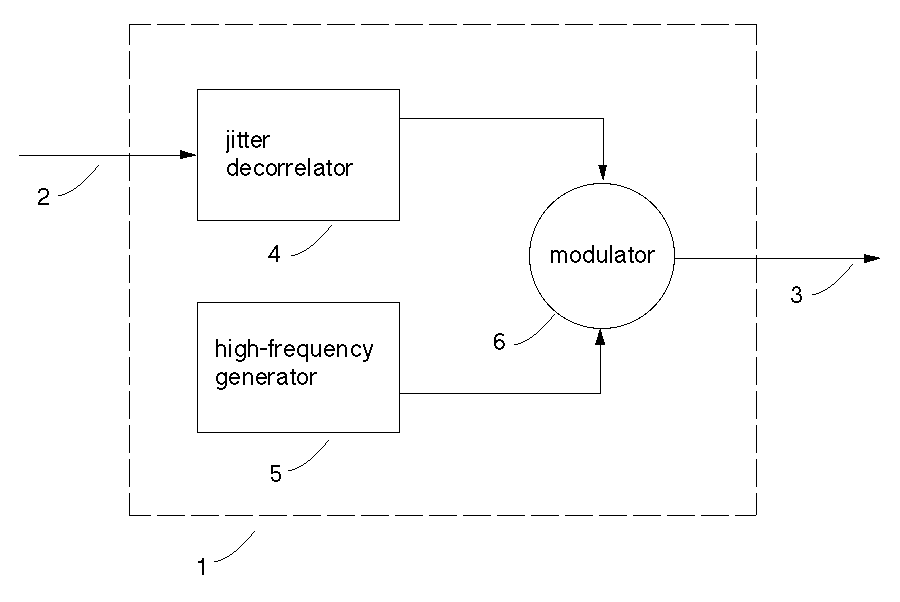Tradeoffs Regarding Jitter Attenuation Devices
There are several questions that arise, when dealing with jitter attenuation devices; these are e.g.
1) If I use a jitter attenuation device like the AMM-UPCI (or other), will I still be able to hear differences between different transports, different cables prior to the attenuation device or different CDs containing the same digital data (e.g. CD vs. CD-R)?
- If you had an ideal jitter attenuation device, you would not be able to hear any sound difference between transports, cables, or CD-types, as long as the original digital data could be retrieved. Research has shown, that although original data is passed to the jitter attenuation device, sonic differences are still perceived. That means, that our jitter attenuation devices are not ideal. As mentioned before, absolutely zero jitter can not be attained.
- A kind of signature of the sending device (e.g. transport) is still coming through virtually all jitter attenuation devices. Although the peak to peak jitter can be brought to very low levels, the jitter correlations remain intact, and these are easily recognized by the human ear.
- Even in memory based systems those signatures are able to slip through the attenuation process. It is, however, possible to break „all“ correlations and maintain very low output jitter, with large memories and intelligent loop filter algorithms implemented in the software. This approach is quite expensive and not very flexible. A certain amount of RAM space and processing power is required. A larger amount of electronic components is needed. They can introduce new jitter, due to the noise, that can contaminate the attenuators power supply.
2) If I have multiple sources of program material, that have different sampling rates (CD, DAT, DVD) and are connected to a single DAC, do I need a sepearate standard jitter attenuation device for each sampling rate?
- Yes, most jitter attenuation devices can only process one sample rate. If you use different sample-rates in your audio setup, you have to have a single jitter attenuation device for every sample rate you use (e.g. 1 for 48kHz DAT, 1 for 44,1kHz CD, one for 96kHz DVD).
3) Can I use a standard jitter attenuation device in a multichannel, Dolby Digital or DTS application?
- This is not possible with most jitter attenuation devices.
- There are jitter attenuation devices available for Dolby Digital or mixed sources applications, but these still share the problems of a standard jitter attenuation device. If such a multi-source device would be realized with VCXO clocking it would be expensive and not compatible to varispeed applications. If if would be realized with VCO clocking, it would simply not allow effective jitter attenuation.
4) Can I use a standard jitter attenuation device in varispeed (DJ) applications?
- No, since all effective jitter attenuation devices use VCXO clock sources for high precision, varispeed applications are not supported. The VCXO can only generate one frequency with a very narrow pulling range.
A New Technology
In order to overcome all of the above limitations ALTMANN MICRO MACHINES has developed a new proprietary technology called:
JITTER SCRAMBLING DECORRELATION
The worlds first device incorporating this new technology, the AMM-JISCO (patents applied for) is in production now and can be ordered from this website.

The AMM - JISCO should not really be called a jitter attenuator, because the peak to peak jitter at the output of the AMM-JISCO is larger than the jitter at its input. It is not important to have low jitter at the digital input of the DAC receiver, however, it is very important to have low jitter at the actual DAC-chip, in the DAC device.
You can read in the following lines, to see how this is accomplished.
The AMM - JISCO is a JITTER SCRAMBLING DECORRELATOR (see data sheet)
We will discuss its function with respect to the following block diagram:
(This is a strongly simplified block diagram. The actual implementation requires additional functions and associated circuitry.)

The incoming signal (2) (e.g. CD or DVD or SACD or DAT etc. transport /player) passes the jitter decorrelator block (4), that executes the real-time scrambling algorithms.
A modulator (6) performs a jitter frequency shift of the decorrelated signal using an ultra stable high frequency generator.
The jitter at the output of the modulator (3) has its energy shifted to higher frequencies, where it has no influence on the clock recovery PLL of the receiving device. This could be a DA converter, DAT recorder or AD converter, etc.
Specifically, what happens is this: Every receiving device (e.g. a DA or AD converter) has at its input a clock extraction PLL (in order to divorce the clock and data signal from the S/PDIF or other input stream). This clock extraction PLL is implemented into a receiver chip (e.g. the Crystal CS8414) and has its own jitter attenuation characteristic (see the CS8414 datasheet on page 8). This internal jitter attenuation is very ineffective in practical situations, because no attenuation is performed below jitter frequencies of approximately 10kHz.
Unfortunately CD and other transports generate lots of jitter below 10kHz.
If you take a second look at the jitter attenuation diagram of the CS8414 data sheet, you will see that relatively good attenuation is performed at 1MHz and you can interpolate that attenuation will be much better at even higher frequencies, not printed in the diagram (the designers of the CS8414 could not know, that we can exploit this feature now).
After scrambling the incoming jitter, the AMM - JISCO shifts the jitter into a high frequency range of several MHz. The receiver chip of the following device is able to strongly attenuate this jitter, so that the actual jitter at the DAC chips is low and NOT CORRELATED TO THE SIGNAL SOURCE. This principle works with all receivers and clock extraction PLLs since it is a common design necessity of any PLL circuit that the loop filter attenuates higher frequencies.
It can be said that this introduces a seeming paradox: By generating large amounts of jitter, the actual jitter at the DAC chip is reduced. The jitter paradox. This is how the ultimate goal, of low jitter at the DAC chip, is accomplished.
Due to the scrambling facilities of the AMM-JISCO, the signature of a signal transmitter (e.g. CD transport) will be attenuated. That means, that the perceivable differences between different transports, digital cables, CD/CD-R are strongly reduced and are less obvious compared to conventional jitter attenuation.
The JISCO technology is independent of sampling frequency, data size and data format. Therefore one single AMM-JISCO device is able to process 32, 44.1, 48, 96, 192 kHz or any value in between at any data size. It is also able to process varispeed signals (slowly changing sample rates) and other than S/PDIF formats (e.g. Dolby Digital, MP3).
Now how does it sound?
We were shocked.
Since we had some experience in designing jitter attenuation devices, we were surprised about the sound quality available through the JISCO technology.
In all listening tests, regardless of data format or equipment, the AMM-JISCO device always delivered superior sound quality compared to conventional jitter attenuation devices.
It will also greatly improve the sound quality of integrated CD players with a digital output and input. The AMM-JISCO can be attached using either coax or TOSLINK connectors. Normally, a TOSLINK connection is not a prefered choice for connection. However, due to the scrambling feature in the decorrelation block, of the AMM-JISCO, the jitter components normally generated with a TOSLINK connection, are rejected in the AMM-JISCO processing.
It should be noted that the internal signal path of a CD-player is not able to deliver as high a sound quality, as an external signal path that includes the AMM-JISCO processing. This is true, even though an external signal path has traditionally introduced additional jitter, such as with a Toslink connection.
According to our knowledge at this point in time, and according to the results of numerous tests with all kinds of equipment, we can confidently state the superior advantages of our new JISCO technology in one sentence:
If you are not using the AMM-JISCO technology, your audio quality is not as good as it could be.
Customer's Reviews and Questions
Several units of the JISCO have now been shipped to customers worldwide. We have received links to some reviews, that we would like to share with you:
http://www.AudioAsylum.com/audio/digital/messages/2154.html
http://www.AudioAsylum.com/audio/digital/messages/2901.html
http://www.audioasylum.com/audio/digital/messages/3220.html
Below are some interesting reviews, that I got from customers by email.
Prices & Shipping
We are currently shipping the JISCO MKII which has a higher scrambling frequency (50MHz) compared to previous model JISCO.
The price is EUR 1200,- for the JISCO MKII with TOSLINK or RCA (Cinch) input.
Update price from JISCO to JISCO MKII is EUR 550,-
The AMM - JISCO MKII is covered by a 5 years limited guarantee.
Payment is prepaid to our account.
![]() We will pay World Wide Shipping for You!
We will pay World Wide Shipping for You! ![]()
No matter, where you live. We will pay the price for a standard world wide air parcel. Delivery will take 5..10 business days.
Please order by email.
Text (c) by Charles Altmann